Civil Justice Statistics Quarterly: July to September 2021
Published 2 December 2021
1. Main Points
| Covid-19 and associated actions are still having an impact on all civil actions | This quarter, civil justice actions remain below pre-Covid-19 levels. Following the marked recovery seen in recent quarters as a result of the impact of measures undertaken by the courts, volumes of all actions show signs of stabilising in the most recent quarter. This publication will therefore focus largely on comparisons with the same quarter two years ago (a pre-Covid-19 baseline). |
| Decrease in County Court claims driven by money claims and possession claims | In July to September 2021, County Court claims were down 27% on the same period in 2019, to 404,000. Of these, 332,000 (82%) were money claims (down 26%). Compared to the same quarter in 2020, County Court claims were up 39%. |
| Damages claims were up 8% at 34,000 | The increase in damages claims was driven by an uptick in Other damages claims (up 337% to 13,000) compared to the same quarter in 2019. This was offset by Personal Injury claims (down 26% to 21,000). Compared to the same quarter in 2020, total damages claims have fallen (down 10%). |
| The number of claims defended and number of trials is lower than 2019 | There were 72,000 claims defended (down 8%) and 13,000 claims that went to trial in July to September 2021 (down 24%). Compared to the same quarter in 2020, claims defended were up 17% and claims that went to trial increased by 19%. |
| Mean time taken from claim to hearing has increased | The mean time taken for small claims and multi/fast track claims to go to trial was 50.7 weeks and 70.6 weeks, 12.6 weeks longer and 11.3 weeks longer than the same period in 2019 respectively. These measures were also 1.9 weeks and 8.4 weeks longer for the same quarter in 2020 respectively. |
| Judgments were down 17% and default judgments were down 15% | Judgments were down 17% (to 285,000) in July to September 2021, compared to the same period in 2019; with 92% of these being default judgments. Compared to the same period in 2020, judgments were up 106%. |
| 15,000 enforcement applications and 10,000 enforcement orders made | Enforcement applications were down 41% while enforcement orders were down 37%. Compared to 2020, enforcement applications were up 67% while enforcement orders were up 47%. |
| 69,000 warrants were issued | Warrants issued were down 38% when compared to the same quarter in 2019 and up 415% compared to 2020. |
| 1,800 judicial review applications so far in 2021 | There were 1,800 applications for Judicial Reviews in the first three quarters of 2021, down 19% on the same period in 2020 (here we are comparing to 2020 data as JR cases were not significantly impacted by Covid-19). Of the 900 cases in 2021 that reached the permission stage, 128 (14%) were found to be ‘totally without merit’. |
This publication gives civil county court statistics for the latest quarter (July to September 2021), compared to the same quarter in 2019 (pre-Covid19). Should users wish to compare latest outturn against 2020, they can do so using the accompanying statistical tables. The judicial review figures cover the period up to July to September 2021. For more details, please see the supporting document.
Statistics on the Business and Property Court for England and Wales have also been published alongside this quarterly bulletin as Official Statistics. For technical detail, please refer to the accompanying support document.
For general feedback related to the content of this publication, please contact us at: CAJS@justice.gov.uk
2. Statistician’s comment
Volumes across most Civil Justice data have remained relatively stable in 2021 following recovery from the impact of Covid-19 in the first half of 2020, although numbers remain below pre-Covid-19 levels. We continue to compare the data from this quarter with the equivalent quarter in 2019 (as a pre-Covid-19 baseline) for a more meaningful assessment of trends and performance and a better measure of how the civil process “returns to normal”. We expect to return to the usual practice from next year, when the Covid-19 impact is likely to have washed out of the data. Should users wish to compare latest outturn against 2020, they can do so using the accompanying statistical tables.
The recovery noted over the last few quarters has slowed in most areas across civil justice. However, the number of judgements in the county courts has continued to increase in this quarter, albeit was still 17% below the same quarter in 2019. Recovery in the volume of claims defended has also slowed in 2021. This remains the area where recovery is most evident with volumes just 8% lower than the equivalent 2019 quarter (pre-Covid). The mean time taken from claim to hearing remains significantly negatively impacted by Covid-19 however.
Total claim volumes have remained relatively stable in 2021, yet the quantum of “other” damages claims have continued to rise (up 337% on the 2019 comparator and 139% on the same quarter in 2020). As noted previously, this increase is as a result of PPI-related claims that rely on a section of the Consumer Credit Act that relates to unfair relationships and follows a series of court rulings on the matter. Possession claims have also continued to increase, following the end of stays in possession actions in England (31st May) and Wales (30th June), although these remain 63% below levels in the same quarter of 2019.
Looking ahead, as Covid-19 restrictions have come to an end, claim volumes are likely to return to historic trend levels but we expect timeliness measures to remain impacted for some time. As timeliness measures are taken from the initial claim date, data for the next few quarters is likely to continue to include some cases issued before or during the early stages of the pandemic. Measures implemented following the pandemic, such as the opening of Covid secure courtrooms and the increase in hearings by remote means, will have benefited later cases and as such should begin to impact on timeliness measures in the next few quarters.
3. Claims Summary
County court claims were down 27% on the same quarter of 2019, driven by money claims and possession claims.
There were 404,000 County Court claims lodged in July to September 2021. Of these, 367,000 were money and damages claims (down 24% from July to September 2019).
Non-money claim volumes were at 37,000, down 47% when compared to the same quarter in 2019.
Mortgage and landlord possession claims were down 63% over the same period to 13,000, ‘other non-money claims’ were down 30% to 22,000 and claims for return of goods were down 27% to 2,100.
Figure 1: County Court claims by type, Q3 (July to September) 2016 to Q3 (July to September) 2021 (Source: table 1.2)
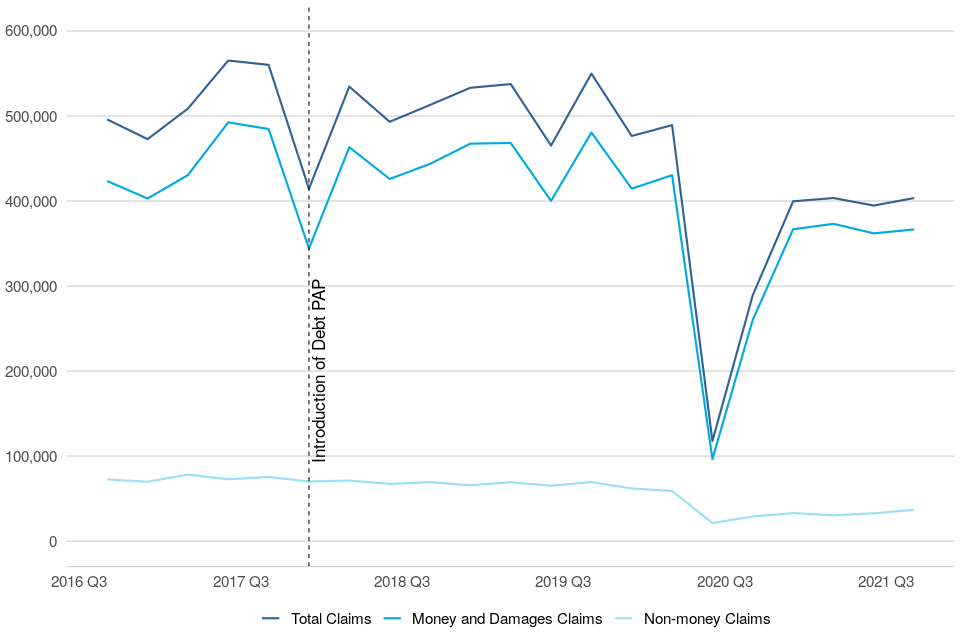
In the most recent quarter, total claims were down 27% compared to the same period in 2019 (from 550,000 to 404,000). Of these, 367,000 were money claims, down 24% from July to September 2019 (from 481,000). Money and damages claims made up 91% of all claims in July to September 2021, up 3pp on its share in July to September 2019.
Prior to the sharp fall in 2020, County Court claims had been generally increasing from 2015, reaching a peak of 565,000 claims in April to June 2017. This increase was driven by a rise in money claims, which make up the majority of claims received. Prior to 2020, claim volumes had been relatively unchanged but volatile, driven by a few “bulk issuers” slowing down and then ramping up their volume of claims. Claim volumes decreased significantly following the outbreak of Covid-19, with volumes this quarter remaining relatively stable following initial recovery towards pre-pandemic levels in the second half of 2020.
Non-money claims have been generally decreasing since 2015. While these showed less of an impact following Covid-19 in contrast to money and damages claims, the recovery to pre-Covid volumes has been slow. In the current quarter, these claims were down 47% (from 69,000 to 37,000) compared to the same period in 2019.
Within non-money claims, ‘other’ non-money claims have shown a decline since 2018. In the most recent quarter, these were down 30% (from 31,000 to 22,000) compared to the same period in 2019.
The overall trend in Mortgage and Landlord Possession claims has been decreasing since a peak of 60,000 in January to March 2014. There were 13,000 claims in July to September 2021, down 63% compared to the same quarter of 2019 (35,000 claims). This decrease has been driven by a fall in all claims types since March 2020 due to actions following Covid19. Further details can be found in the Mortgage and Landlord Possessions publication annex here.
Claims for return of goods increased steadily to a high of over 3,000 in July-September 2018, with this trend stabilising in recent quarters. This quarter, as for other claim types, claims for return of goods were down 27% (from 2,900 to 2,100) in July to September 2021 compared to the same period in 2019.
4. Money Claims[footnote 1]
To align with new terminology within MoJ, specified money claims are now referred to as “Money Claims” and unspecified money claims are now referred to as “Damages Claims”.
Money claims were down 26% (to 332,000 claims) in July to September 2021 compared to the same quarter in 2019, driving the overall trend in money and damages claims.
Money claims of up to (and including) £1,000 were down 30% over this period to 207,000, driving the overall trend in money claims.
Damages claims were up 8% at 34,000, driven solely by a rise in Other - damages claims (up 337% to 13,000) compared to the same quarter in 2019.
Personal Injury claims accounted for 62% of all damages claims in the most recent quarter, down 29pp on July to September 2019, when they accounted for 91% of all claims.
Figure 2: Money claims by monetary value, Q3 (July to September) 2016 to Q3 (July to September) 2021 (Source: civil workload CSV[footnote 2])
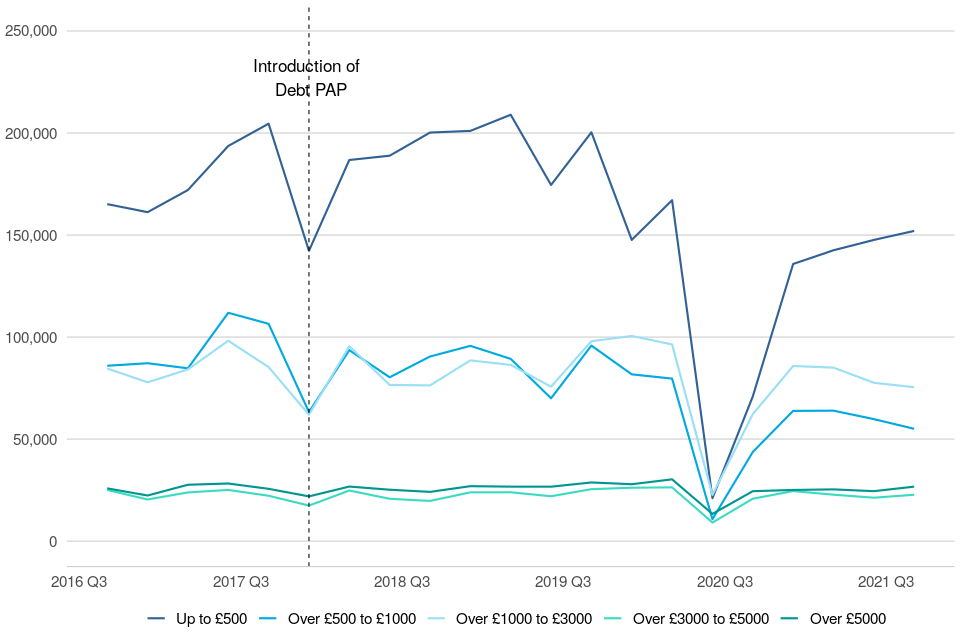
Historically, money claims reached a peak in October to December 2017, at which point the implementation of the Pre-Action Protocol (PAP) for Debt Claims in October 2017 led to a sharp drop in claims. An increasing trend resumed the following quarter, suggesting that the impact of the PAP on claim volumes was temporary. The main aim of the protocol is to encourage early engagement between parties to resolve disputes without needing to start court proceedings. In the most recent quarter (July to September 2021), there were 332,000 claims, down 26% on the same quarter in 2019 (449,000 claims).
This quarter, the majority (84%) of money claims were processed and issued at the County Court Business Centre (CCBC). There were 279,000 such claims at the CCBC in July to September 2021 (down 27% on the same quarter in 2019). CCBC claims have been particularly affected by Covid-19 and associated actions, with a more significant decrease than other money claims, but they have now returned to historic trend levels. For comparison, they made up 85% of money claims in July to September 2019). This is as a result of bulk issuers almost completely ceasing their issue during the immediate response to the pandemic and now increasing these volumes.
The change in money claims is driven by lower value claims (under £1,000). These were down 30% to 207,000 claims in the period July to September 2021, compared to 2019, and account for just 62% of total money claims in the most recent quarter. This is a return to historical levels following the previously noted significant decline, with this category making up 66% of total money claims in July to September 2019. When compared to the same quarter in the previous year, the next claim band (above £1,000 up to and including £3,000) was initially similarly affected but has now returned to around historic levels with 75,000 claims. As a result, this value bracket made up 23% of total money claims in the most recent quarter, similar to its share in July to September 2019 (22%).
Other than Q2 2020, damages claims have fluctuated between 30,000 and 40,000 claims each quarter over the last five years (since July to September 2016). More recently, the volumes were up 8% in July to September 2021 compared to the same period in 2019 (at around 32,000). This was driven by an increase in other damages claims, up 337% from 3,000 to 13,000; this is at its highest level since quarter 1 of 2012 (when there were 14,000 claims). That increase was offset by a fall in personal injury claims, down 26% compared to the same period in 2019 (from 29,000 to 21,000). The increase in other damages claims is as a result of PPI-related claims that rely on a section of the Consumer Credit Act that relates to unfair relationships and follows a series of court rulings on the same matter. As the increase has been maintained for a few quarters, we intend to provide further analysis on this case type in the next few quarters.
4.1 County court claims by month and 5-year average
Claims for quarter 4 of 2020 and quarters 1 to 3 of 2021 – which covers the second peak Covid-19 period, have been shown by month (figure 3) to further examine the impact of the pandemic and related actions on claim volumes in county courts over this period.
Figure 3: Monthly county court claims by type, 2019, October 2020 to September 2021, and 5-year average

Money claims initially fell steeply in March 2020 (down 29% on 2019 - not shown in figure 3), coinciding with wide-scale closure of courts[footnote 3] across England and Wales as a result of Covid-19, and many bulk claim issuers “pausing” new claims following guidance from the FCA[footnote 4]. This was followed by further falls in April and May with just 21,000 and 22,000 claims respectively (down more than 70% on the five-year average in both cases).
The first significant uptick was seen in June, and this continued into Q3 of 2020 with 55,000 and 63,000 claims in July and August. After the continued recovery in September 2020, October claim volumes, at 135,000 claims, were up 26% on the 5-year average, although still down 13% on the higher volumes seen in 2019. This recovery seems to have continued over the last few months with the levels generally remaining between the 5-year average and the higher 2019 levels. The latest three months (110,000, 122,000 and 100,000 claims respectively) have continued this trend.
Damages claim volumes did not see such a significant decline; at the lowest points this reached 4,800 claims in April 2020, down 57% on the five-year average (not shown in figure 3). A partial recovery to pre-Covid levels had commenced by June 2020, with claim volumes only down 29% on the five-year average. The recovery reached levels consistent with previous years in August and September 2020 and this pattern has continued (11,000, 10,000 and 13,000 claims for July, August and September respectively).
In contrast, non-money claim volumes had declined significantly by April 2020, reaching just 5,400 claims, down 76% on the five-year average. Following this, volumes rose slightly through May-July, reaching a high of 10,000 in July 2020, still down 63% on the five-year average. Claim volumes have fluctuated slightly since then (13,000, 12,000 and 13,000 claims respectively for July, August and September of 2021). September was down 51% on the 5-year average and showed no signs of returning to pre-Covid levels yet.
4.2 Allocations (table 1.3)
In July to September 2021, 37,000 money and damages claims were allocated to track, down 27% (from 51,000) on the same period in 2019. A decrease was seen across all tracks. Compared to July to September 2019, of these allocations:
- 22,000 were allocated to small claims, down 29% on July to September 2019. This accounts for 60% of all allocations (compared to 62% of all allocations in the same quarter of 2019);
- 12,000 were allocated to fast track, down 24% on July to September 2019. This accounts for 33% of all allocations (compared to 31% of all allocations in the same quarter of 2019);
- 2,400 were allocated to multi-track, down 25% on July to September 2019. This accounts for 7% of all allocations (compared to 6% of all allocations in the same quarter of 2019);
5. Defences (including legal representation) and Trials
The number of claims defended was down 8% to 72,000 compared to the same quarter in 2019.
Of those claims defended, 59% had legal representation for both claimant and defendant, 25% had representation for claimant only, and 3% for defendant only.
The number of trials was down 24% to 13,000 compared to the same quarter in 2019
Average time taken for small claims was 50.7 weeks (12.6 weeks longer compared to the same quarter in 2019) and for multi and fast track claims it was 70.6 weeks (11.3 weeks longer than July to September in 2019).
Of those claims defended in July to September 2021, 59% had legal representation for both claimant and defendant, 25% had representation for claimant only, and 3% for defendant only. Almost all (95%) damages claim defences had legal representation for both the defendant and claimant, compared with 37% of money claim defences.
Changes in representation compared to the same quarter last year is primarily influenced by the larger fall in money claim volumes in comparison to damages claims, with the latter being more likely to have representation for both parties.
Figure 4: Proportion of civil defences and legal representation status, July to September 2021 (Source: table 1.6)

The total number of claims defended was down 8% in July to September 2021 compared to the same quarter in 2019, from 78,000 to 72,000 cases. This was driven by decreases across all claim types, with the most significant impact from money claims being defended (down 13% from 48,000 to 42,000). However, it should be noted that this fall in money claims defended (down 13%) is less than the fall in money claims issued (down 26%).
Figure 5: Monthly county court claims defended, 2019, October 2020 to September 2021, and 5-year average
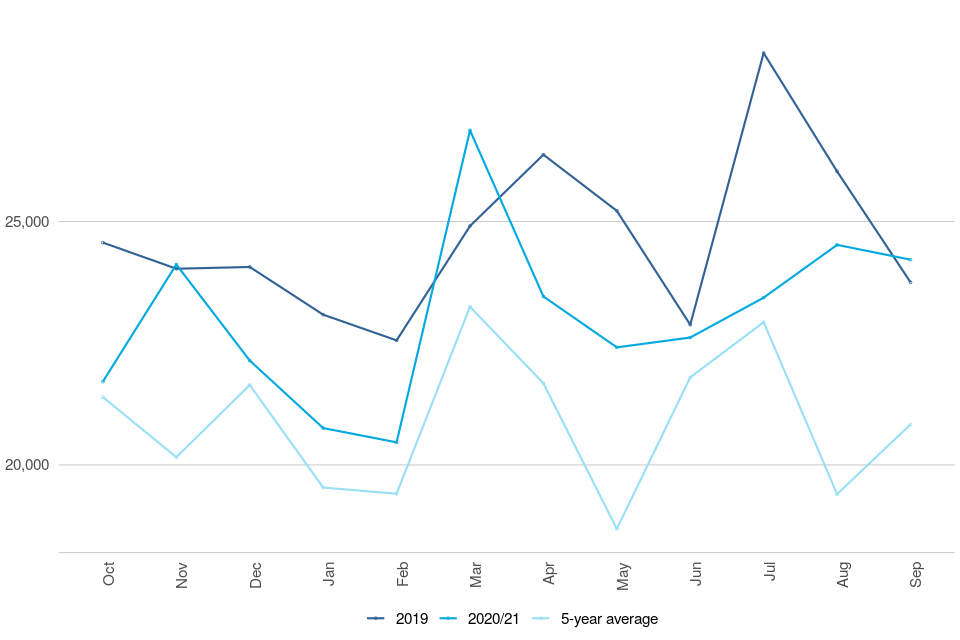
As with total claims, the monthly breakdown of claims defended in figure 5 shows variance throughout the last year. Due to the time taken from claim to defence, the initial decline in defence volumes was not seen until April 2020, where claims defended were down 10% to 19,000, followed by a more significant fall in May 2020 to 12,000 defences. Defence volumes then showed a steady recovery through June and July 2020 (14,000 and 17,000 defences respectively). By August 2020, defence volumes were up 1% on the five-year average (20,000 defended claims) and continued to rise, with September 2020 volumes (25,000 defended claims) being up 19% on the 5-year average, as well as up 4% on the higher volumes seen in 2019.
This recovery continued in Q4 2020 and 2021 but had not been steady until the last six months. The most recent monthly figures (23,000, 25,000 and 24,000 defended claims for July, August and September respectively) have started to show a return to pre-Covid levels. Whilst monthly data is more volatile, September was up 16% on the 5-year average and up 2% on the higher volumes seen in 2019.
5.1 Trials and Time Taken to Reach Trial (table 1.5)
Defended cases which are not settled or withdrawn, generally result in a trial. In total, there were 13,000 trials in July to September 2021, down 24% compared to the same period in 2019. Of the claims that went to trial, 9,400 (71%) were small claims trials (down 25% compared to the same quarter in 2019) and 3,800 (29%) were fast and multi-track trials (down 22% from the same quarter of 2019).
Figure 6: Average number of weeks from claim being issued to initial hearing date, Q3 (July to September) 2016 to Q3 (July to September) 2021 (Source: table 1.5)
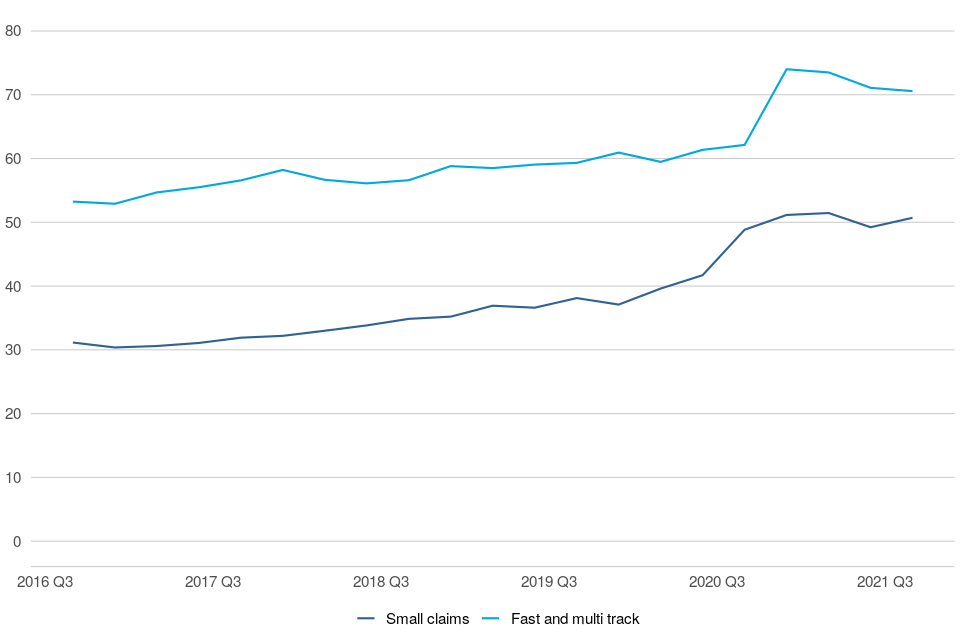
In July to September 2021, it took an average of 50.7 weeks between a small claim being issued and the claim going to trial, 12.6 weeks longer than the same period in 2019.
Small Claims have been disproportionally impacted by Covid-19 in terms of timeliness for a number of reasons. These claims have shorter timeframes to begin with, and so delays will be observed sooner in the timeliness figures, whereas delayed Fast and Multitrack claims may not yet have reached a hearing. Small claims may also be less suited to remote hearings as they tend to be in person claims rather than professional users.
Measures put in place to help with the backlog of small claims include: Small Claims Mediation (re-referring cases back to mediation) and Early Neutral Evaluation (where a judge will try and engineer agreement without any finding on the fact). These measures, when successful, result in outcomes which are not used within the timeliness calculations. This means the final cases used in timeliness measures include a disproportionate number of more complex cases which take longer to dispose of.
For multi/fast track claims, it took on average 70.6 weeks to reach a trial, 11.3 weeks longer than in July to September 2019 – continuing to exceed the upper limit of the range 2009-2019 (52 to 62 weeks).
Covid-19 and associated actions have led to an uptick in time taken for all claims to reach trial. Prior to this, a sustained period of increasing receipts had increased the time taken to hear civil cases and caused delays to case progress. Additional venues have been provided to add temporary capacity to hear cases and help the court and tribunal system to run effectively.
6. Judgments
Judgments were down 17% compared to same quarter in 2019
There were 285,000 judgments made in July to September 2021, compared to 342,000 in the same quarter of 2019. Of these judgments, 261,000 (92%) were default judgments.
Figure 7: All claims, judgments and default judgments, Q3 (July to September) 2016 to Q3 (July to September) 2021 (Source: tables 1.2 and 1.4)
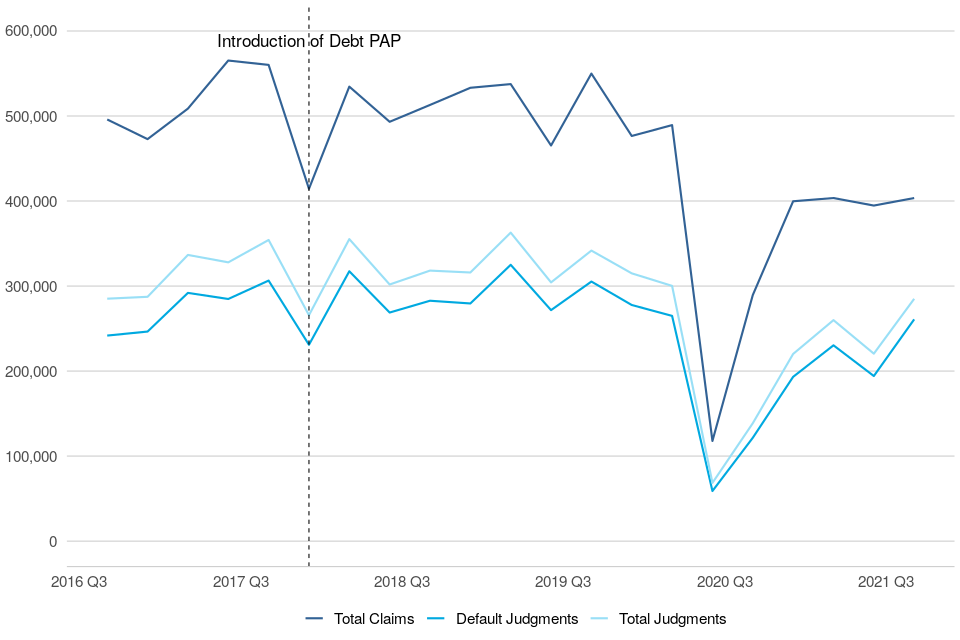
There were 285,000 judgments made in July to September 2021, down 17% compared to the same quarter of 2019. Of these, 92% were default judgments, up 2pp on its share in July to September 2019.
The second largest type of judgment was ‘judge’, of which there were 8,400 in July to September 2021, down 34% on the same quarter in 2019 (from 13,000). ‘Judge’ judgments accounted for 3% of all judgments.
7. Warrants and Enforcements
Warrants issued were down 38% when compared to same quarter in 2019
In July to September 2021, 69,000 warrants were issued, down 38% from 110,000 in the same quarter of 2019. Of these, 63,000 (91%) were warrants of control, down 30% compared to the same period in 2019.
Enforcement applications were down 41% and enforcement orders were down 37% when compared to July to September 2019
All application categories were down on July to September 2019 except for administration applications which rose marginally from 28 to 30. However, these are small numbers and prone to volatility. Attachment of earnings (AoE) applications were down 46% (from 17,000 to 9,100), while AoE orders were down 52% (from 7,600 to 3,600).
Figure 8: Warrants and enforcements issued – Q3 (July to September) 2016 to Q3 (July to September) 2021 (Source: tables 1.7 and 1.8)

7.1 Warrants (table 1.7)
In the latest quarter (July to September 2021) there were 69,000 warrants issued, down 38% (from 110,000) on the same quarter in 2019; this decline was due to the continuing impact of Covid-19 and related actions.
Figure 9: Monthly warrants issued by type, 2019, October 2020 to September 2021, and 5-year average

A monthly breakdown of warrants issued shows a particularly sharp decline due to the initial impact of Covid-19. Following a significant decline in Q2 of 2020 (not shown), warrant volumes generally increased gradually from July 2020. Volumes peaked at 24,000 in February 2021, up 10% on the five-year average. They fell back to 6,700 in May but increased in June and remain relatively stable for July, August and September (23,000, 25,000 and 21,000 warrants issued respectively), close to volumes in February 2021.
However, different types of warrants have shown different patterns. As warrants of control are the majority of warrants issued, they have dominated the overall pattern and these also peaked at 23,000 in February before falling to 5,400 in May, down 75% on the five-year average. This volatile pattern was caused by large backlogs being issued by key bulk issuers in August, as well as local Covid restrictions in September. The volatility has continued in the latest quarter (21,000, 23,000 and 19,000 warrants of control for July, August and September respectively). These were up 74%, up 99% and up 101% respectively compared to the 5-year average.
In contrast, other warrant types have remained low throughout the last year, although these increased slightly in June to 2,400 but have since decreased marginally with 2,100, 1,900 and 1,900 issued in the latest three months (down 77%, down 77% and down 79% respectively compared to the 5-year average). The increase in June 2021 was led by warrants of possession and further details on this can be found in the Mortgage and Landlord Possessions publication annex here.
7.2 Enforcements (table 1.8)
In July to September 2021, there were 15,000 enforcement-related order applications (which include attachment of earnings orders, charging orders, third party debt orders, administration orders, and orders to obtain information), down 41% compared to the same quarter of 2019. All application types were down except for administration applications which rose marginally from 28 to 30. However, these are small numbers and prone to volatility. More significantly, attachment of earnings (AoE) applications were down 46% (from 17,000 to 9,100).
There were 10,000 enforcement-related orders made in July to September 2021, down 37% compared to the same quarter of 2019. Orders fell across all types, with the decrease driven by AoE orders, which were down 52% (from 7,600 to 3,600).
Over the longer term, there has been a decreasing trend in enforcement-related applications received and orders made since 2009, possibly due to claimants’ preference for using warrants instead to retrieve money, property or goods.
8. Judicial reviews[footnote 5]
Of the 1,800 applications received so far (January to September) in 2021, 44% have already closed, and 130 were found to be ‘Totally Without Merit’ (14% of cases that reached the permission stage).
There were 1,800 judicial review applications received in 2021, down 19% on the same period in 2020. In 2020, there were 2,800 applications received in total, down 16% on 2019 (from 3,400).
Figure 10: Annual Judicial Review Applications, by type; calendar year 2010-2020 (Source: table 2.1)
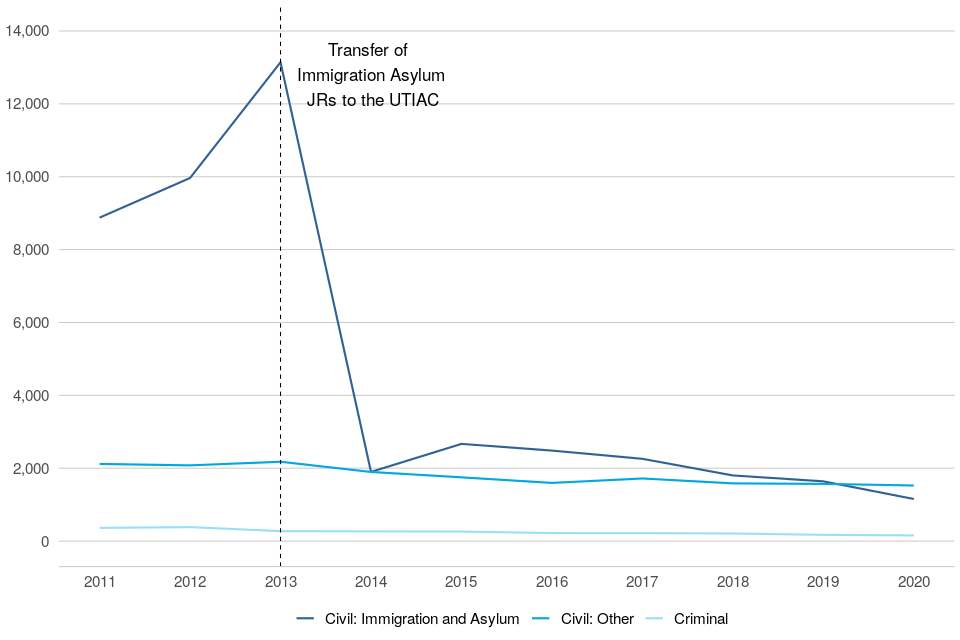
Of the 1,800 applications received in 2021, 600 were civil immigration and asylum applications, 1,100 were civil (other), and 110 were criminal, down 32%, down 9% and down 9% respectively on the same period of 2020. 39 of the civil immigration and asylum cases have since been transferred to the UTIAC.
Of the applications that were made in 2021 in the period January to September, 44% are now closed. Of the total applications, 900 reached the permission stage in 2021, and of these:
- 14% (130) were found to be totally without merit (TWM).
- 270 cases were granted permission to proceed and 620 were refused at the permission stage. However, 44 of the cases refused at permission stage went on to be granted permission at the renewal stage.
- 310 cases have been assessed to be eligible for a final hearing and of these, 29 have since been heard.
- the mean time from a case being lodged to the permission decision was 74 days, slightly up from 69 days across the same period of 2020. The mean time from a case being lodged to final hearing decision was 101 days, similar to the same period of 2020 (139 days).
8.1 Applications lodged against departments (table 2.5)
This quarter’s tables include judicial review figures by defendant type (i.e. individual government department or public body) – table 2.5. This table, which is now published quarterly, provides the number of judicial review applications lodged, permission granted to proceed to final hearing, and decisions found in favour of the claimant at final hearing.
The information presented is derived from the ‘defendant name’ – a free text field completed by the claimant, which is automatically matched and grouped by department. All efforts have been made to quality assure the data presented. However, this is a manually typed field, and as such is open to inputting errors and should be used with caution.
The key findings from January 2021 to September 2021 are:
- The Home Office was the department/body with the largest number of JR applications lodged against them, with 490 applications. Of these, 82 were granted permission to proceed to final hearing (17% of applications) to date.
- The second largest recipient of JR cases was the Local Authorities, with 430 cases received, of which to date 132 were granted permission to proceed to final hearing (30% of applications).
- The third largest recipient was Ministry of Justice, having 360 applications lodged against them. Of these, 33 were granted permission to proceed to final hearing (9% of applications) to date.
A more granular view of the JR data by department and case type can be found in the newly developed data visualisation tool found here. Feedback is welcome on this tool to ensure it meets user needs.
9. Further information
9.1 Provisional data and revisions
The statistics in the latest quarter are provisional and revisions may be made when the next edition of this bulletin is published. If revisions are needed in subsequent quarters, these will be annotated in the tables.
9.2 Accompanying files
As well as this bulletin, the following products are published as part of this release:
- A supporting document providing further information on how the data is collected and processed, as well as information on the revisions policy and legislation relevant to civil justice.
- The quality statement published with this guide sets out our policies for producing quality statistical outputs for the information we provide to maintain our users’ understanding and trust.
- A set of tables providing statistics on the Business and Property Courts of England and Wales.
- A set of overview tables and CSV files, covering each section of this bulletin.
- A new JR data visualisation tool (to provide a more granular view of the JR data by department and case type). This can be found here.
9.3 Rounding convention
Figures greater than 10,000 are rounded to the nearest 1,000, those between 1,000 and 10,000 are rounded to the nearest 100 and those between 100 to 1,000 are rounded to the nearest 10. Less than 100 are given as the actual number.
9.4 National Statistics status
National Statistics status means that official statistics meet the highest standards of trustworthiness, quality and public value.
All official statistics should comply with all aspects of the Code of Practice for Official Statistics. They are awarded National Statistics status following an assessment by the Authority’s regulatory arm. The Authority considers whether the statistics meet the highest standards of Code compliance, including the value they add to public decisions and debate.
It is the Ministry of Justice’s responsibility to maintain compliance with the standards expected for National Statistics. If we become concerned about whether these statistics are still meeting the appropriate standards, we will discuss any concerns with the Authority promptly. National Statistics status can be removed at any point when the highest standards are not maintained, and reinstated when standards are restored.
9.5 Future publications
Our statisticians regularly review the content of publications. Development of new and improved statistical outputs is usually dependent on reallocating existing resources. As part of our continual review and prioritisation, we welcome user feedback on existing outputs including content, breadth, frequency and methodology. Please send any comments you have on this publication including suggestions for further developments or reductions in content.
9.6 Contacts
Press enquiries should be directed to the Ministry of Justice (MoJ) press office:
Sebastian Walters - email: sebastian.walters@justice.gov.uk
Other enquiries about these statistics should be directed to the Data and Evidence as a Service division of the Ministry of Justice:
Laura Jones - email: cajs@justice.gov.uk
Next update: 3 March 2022
-
To align with new terminology within MoJ, specified money claims are now referred to as “Money Claims” and unspecified money claims are now referred to as “Damages Claims”. ↩
-
Following the alignment of the fees for online and paper civil money and possession claims in May 2021 (https://www.legislation.gov.uk/uksi/2021/588/pdfs/uksiem_20210588_en.pdf), figure 2 shows all data with the updated claim brackets for comparison, a further breakdown of these brackets is available within the CSV. The CSV shows updated claim brackets from 2021. ↩
-
https://www.gov.uk/government/news/priority-courts-to-make-sure-justice-is-served ↩
-
https://www.fca.org.uk/publications/finalised-guidance/personal-loans-coronavirus-temporary-guidance-firms ↩
-
The judicial review data are Official Statistics ↩
